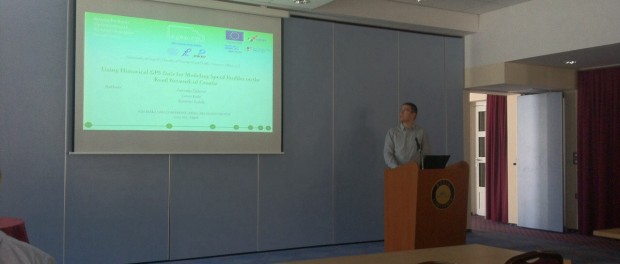Presentation on GNNS Baška conference

From 10-12 of May 2015 in Baška (Krk Island) the 9th GNSS conference was held. SORDITO project team members (Tomislav Erdelić, mag. ing. el. techn. inf., Lovro Rožić, mag. inf. et. math. and Antonija Čičković, mag. math.) participated in the conference with the paper entitled: Using Historical GPS Data for Modeling Speed Profiles on the Road Network of Croatia.
Tomislav Erdelić, mag. ing. el. techn. inf. presented the paper. The paper abstract can be found below:
In this paper we present an analysis of speeds which were calculated by processing GPS data. The data was collected during the 2009 to 2014 period from vehicles tracked on the road network of Croatia. The objective of the analysis was to compute speed profiles in five minute intervals for road segments in digital map of Croatia. Although speed from the GPS record is very precise when the time differences between consecutive data are small, this was not the case with the used historical data as the time gap varied significantly. In order to compute the speeds with more precision we take into account time elapsed and distance covered by vehicle between two consecutive GPS signals.
We show that computing speed profiles by averaging speeds in intervals is not a good approximation of real traffic conditions in time of congestion, due to large deviation inside intervals. Average speed tends to shows optimistic result in time of congestion as the standard deviation is very high. This is in part due to the stochastic nature of traffic congestions, as occurrence time and intensity of congestions can vary. The other, more predictable cause of high standard deviation is seasonality, especially in Croatia which has a high influx of tourists (both local and foreign) near the Adriatic coast during summer months. As a consequence, in times of congestion the continental regions show lower traffic intensity during summer months, while the opposite holds for coastal regions during the same period.
In order to find representative speeds for the time intervals, we analyzed the distributions of speed data based on the time of day. We noticed that the distributions of speed data change during the day, from left skewed distributions during the rush hour to almost symmetric distributions in times of no congestion. Based on these distributions we compare different measures, such as mean, median, modal, i-th percentile and pace, as ways of modeling expected speed on a road segment at a specific time interval.

Leave a comment